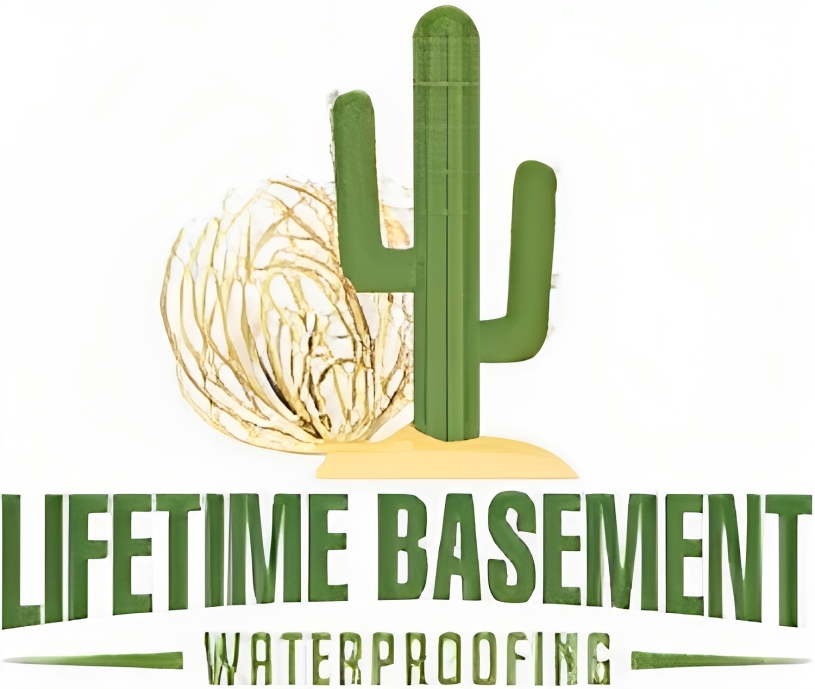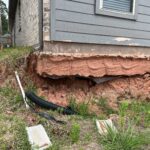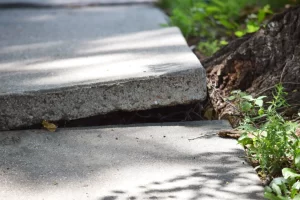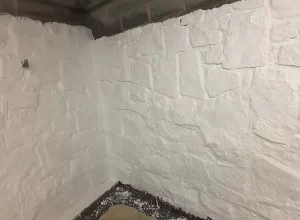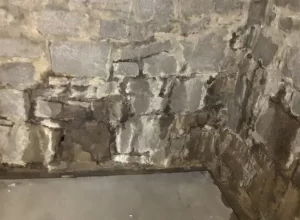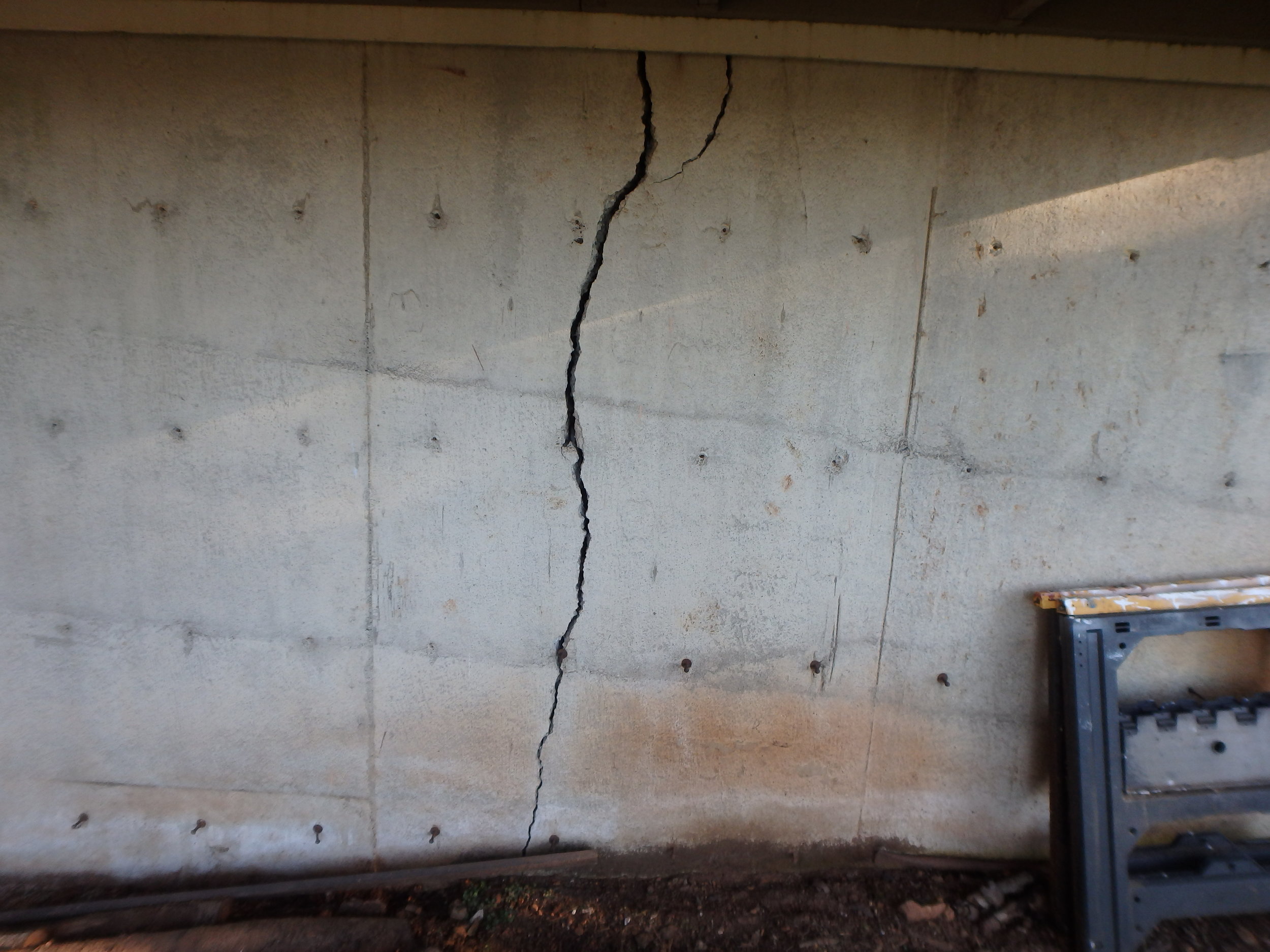
To prevent foundation cracks, prioritize proper grading to direct water away from your home. Choose plants with non-invasive roots and maintain them regularly. Guarantee water drains away by sloping your yard correctly and using drainage systems. Mulch for moisture control and prevent soil erosion. Regularly inspect for issues and consider hardscaping for additional protection. By implementing these landscaping techniques, you can safeguard your foundation from damage and maintain its integrity over time.
Key Takeaways
- Proper grading to direct water away from foundation.
- Strategic plant selection with non-invasive root systems.
- Implementing water drainage solutions like French drains.
- Mulching for moisture control and soil health.
- Regular inspection and maintenance for foundation integrity.
Importance of Proper Grading
To prevent foundation cracks, make sure the appropriate grading of your landscaping. Proper grading is crucial in ensuring that water flows away from your home’s foundation instead of pooling around it. When the grading is done incorrectly, water can accumulate near the foundation, leading to soil expansion and contraction, which can cause cracks over time. To avoid this issue, make sure the soil slopes away from the foundation at a minimum grade of 5% for the first 10 feet. This slope will help direct water away from the base of your home, reducing the risk of cracks forming.
Check the existing grading around your home and fill in any low spots that could collect water. Use compacted soil to build up these areas, ensuring a smooth and consistent slope away from the foundation. Pay attention to the landscaping features near your home as well. Mulch, gravel, or other materials shouldn’t be piled up against the foundation as they can trap moisture and contribute to foundation damage. By maintaining proper grading and keeping landscaping materials away from the base of your home, you can significantly lessen the risk of foundation cracks caused by water accumulation.
Strategic Plant Selection
When selecting plants strategically for your landscaping, consider their mature size and root system to prevent potential damage to your home’s foundation. It’s important to choose plants that won’t pose a threat to the structural integrity of your property.
Here are some essential points to keep in mind:
- Mature Size: Opt for plants that won’t outgrow the space available for them. Trees or shrubs that grow too close to your home can cause foundation issues as their roots expand.
- Root System: Select plants with non-invasive root systems. Some plants have roots that aggressively seek out water sources, potentially causing damage to underground pipes and your foundation.
- Maintenance: Regular maintenance of your landscaping can help prevent overgrowth issues. Pruning and trimming plants can control their size and prevent them from encroaching on your home.
Managing Water Drainage
Considering the impact of water drainage on your landscaping is essential for preventing foundation cracks. Poor water drainage can lead to water pooling around your foundation, causing soil erosion and potential structural damage.
To manage water drainage effectively, start by ensuring that your yard slopes away from the foundation. This slope will help direct water away from the house, preventing it from seeping into the ground near the foundation.
Another way to manage water drainage is by installing a French drain. French drains are underground trenches filled with gravel that help redirect water away from your foundation. By intercepting and diverting groundwater, French drains can prevent excess moisture from accumulating around your home.
Additionally, downspouts and gutters play a significant role in managing water drainage. Make sure your gutters are clean and free of debris to allow water to flow freely. Extend downspouts away from the foundation to prevent water from pooling near the house. You can also consider installing splash blocks at the end of downspouts to further direct water away from the foundation.
Mulching for Moisture Control
Improve moisture control in your landscaping by incorporating mulching techniques. Mulching is a simple yet effective way to help regulate soil moisture levels, protect your plants, and enhance the overall aesthetics of your outdoor space. Here are three key benefits of using mulch for moisture control:
- Retains Moisture: Mulch acts as a barrier between the soil and the sun, reducing water evaporation and helping the soil retain moisture for longer periods. This is especially beneficial during hot and dry weather conditions when water tends to evaporate quickly.
- Prevents Soil Erosion: In addition to retaining moisture, mulch also helps prevent soil erosion caused by heavy rainfall or strong winds. By creating a protective layer over the soil, mulch keeps it in place and reduces the risk of erosion, which can destabilize the foundation of your property.
- Regulates Soil Temperature: Mulch provides insulation to the soil, helping to regulate its temperature. This is essential for maintaining a healthy environment for plant roots, as extreme temperature fluctuations can stress plants and affect their growth. By keeping the soil temperature more consistent, mulch supports overall plant health and well-being.
Incorporating mulching techniques into your landscaping not only helps with moisture control but also contributes to the health and longevity of your plants while adding visual appeal to your outdoor space.
Preventing Soil Erosion
To prevent soil erosion in your landscaping, consider implementing effective erosion control measures. Soil erosion can be a significant issue that not only affects the appearance of your property but can also lead to more serious problems like foundation damage. One way to combat soil erosion is by using ground cover plants or grasses with dense root systems. These plants help hold the soil in place, reducing the risk of erosion caused by wind or water.
Another effective method is to install retaining walls or terraces in areas where soil erosion is a concern. Retaining walls can help stabilize slopes and prevent soil from washing away during heavy rains. Terraces, on the other hand, can help slow down the flow of water and give it a chance to infiltrate the soil, reducing erosion.
Mulching isn’t only beneficial for moisture control but also plays an important role in preventing soil erosion. By spreading mulch around your plants and garden beds, you can protect the soil from the impact of raindrops, which can dislodge soil particles and cause erosion. Additionally, mulch helps to regulate soil temperature and retain moisture, creating a healthy environment for plants while reducing erosion risks.
Regular Inspection and Maintenance
Examining your landscaping regularly and carrying out essential maintenance tasks is crucial for preserving the integrity of your property’s foundation. Ensuring that your landscape is properly maintained can help prevent issues that could lead to costly foundation repairs down the line.
Here are some key tasks to focus on during your regular inspections:
- Check for Standing Water: Pooling water near your foundation can weaken the soil and eventually cause cracks. Make sure your yard is graded away from the foundation to avoid water accumulation.
- Inspect for Tree Roots: Tree roots can grow extensively underground and potentially disrupt the foundation. Regularly check for any tree roots encroaching on the foundation and address the issue promptly.
- Monitor for Soil Settlement: Keep an eye out for any areas where the soil around your foundation is settling unevenly. This settlement can create pressure imbalances on the foundation, leading to cracks over time.
Utilizing Hardscaping Features
Enhancing your landscaping with hardscaping features can greatly contribute to the stability and aesthetics of your property’s foundation. Hardscaping elements like retaining walls, pavers, and pathways not only enhance the visual appeal of your outdoor space but also play an important role in preventing foundation issues. By strategically incorporating these features into your landscape design, you can effectively manage water drainage, minimize soil erosion, and reduce the risk of foundation cracks caused by shifting soil.
Retaining walls are particularly valuable in hardscaping for their ability to provide structural support and prevent soil movement. By creating terraced levels in your yard with retaining walls, you can control water runoff and keep soil in place, thereby reducing the pressure on your foundation. Additionally, pathways made of durable materials like concrete or stone can help divert foot traffic away from sensitive areas around your home, preserving the integrity of the soil and foundation.
When planning your hardscaping project, consider consulting with a landscaping professional to make sure that the design not only enhances the beauty of your property but also serves a functional purpose in protecting your foundation. Proper installation and maintenance of hardscaping features can go a long way in safeguarding your home against foundation cracks and other structural damage. By investing in quality hardscaping, you can enjoy a beautiful landscape while keeping your foundation secure for years to come.
Frequently Asked Questions
Can Foundation Cracks Be Caused by Tree Roots Growing Too Close to the House?
Indeed, tree roots growing too close to the house can cause foundation cracks. They apply pressure on the foundation, resulting in cracks over time. Maintaining the appropriate distance between trees and the house is crucial to prevent damage.
How Can the Presence of Clay Soil Affect the Likelihood of Foundation Cracks?
Clay soil can lead to foundation cracks due to its inclination to expand and contract with moisture changes. To prevent this, guarantee proper drainage around your home and consider using landscaping techniques like grading.
Are There Any Specific Types of Plants That Can Actually Contribute to Foundation Cracks?
Certain plants with invasive root systems, like willows or silver maples, may contribute to foundation cracks by seeking moisture near your home’s foundation. Planting them too close can lead to potential damage. Be cautious.
What Role Does the Slope of the Landscape Play in Preventing Foundation Cracks?
To prevent foundation cracks, make sure the landscape slopes away from your home. Proper grading helps divert water, preventing pooling that can damage the foundation. Maintain a slope of at least 6 inches over the first 10 feet.
Are There Any Warning Signs of Potential Foundation Issues That Homeowners Should Be Aware Of?
Pay attention to warning signs like cracks in walls, sloping floors, or doors sticking. These could indicate potential foundation issues. Don’t ignore these signals; they might save you from costly repairs in the future.
Conclusion
Lifetime Basement Waterproofing has been Atlanta’s premier basement waterproofing company for over 30 years. As a family-owned and operated company, we specialize in basement waterproofing and offer a range of expert services.
Our expertise includes crawlspace encapsulation, exterior foundation waterproofing, foundation crack repair, and strategic drainage solutions such as French drains.
When you choose Lifetime Basement Waterproofing, you can trust us for all your wet basement repair needs.
